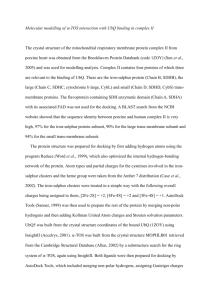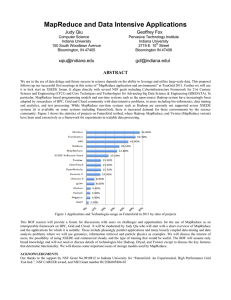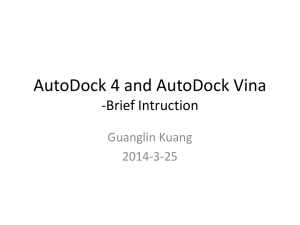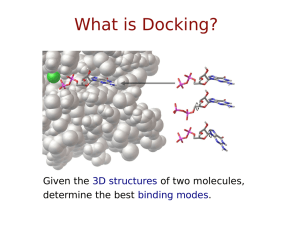A Hierarchical Framework for Cross‐Domain MapReduce Execution
advertisement
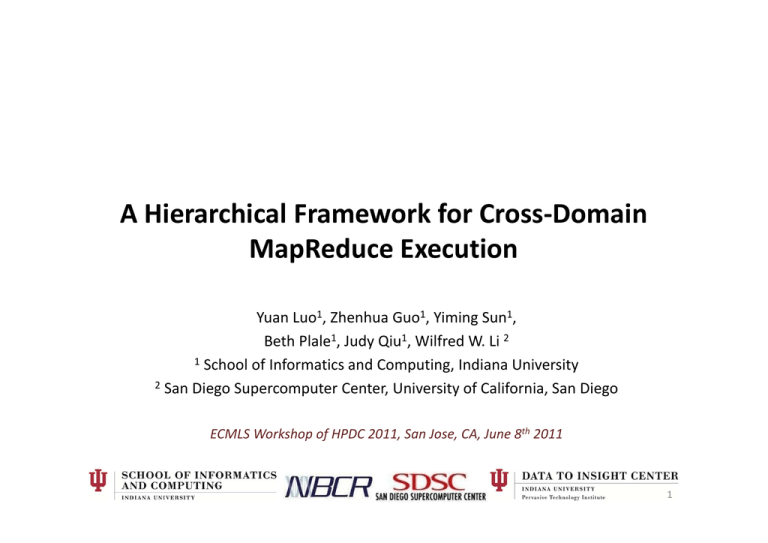
A Hierarchical Framework for Cross‐Domain MapReduce Execution Yuan Luo1, Zhenhua Guo1, Yiming Sun1, Beth Plale1, Judy Qiu1, Wilfred W. Li 2 1 School of Informatics and Computing, Indiana University 2 San Diego Supercomputer Center, University of California, San Diego ECMLS Workshop of HPDC 2011, San Jose, CA, June 8th 2011 1 Background • The MapReduce programming model provides an easy way to execute embarrassingly parallel applications. • Many data‐intensive life science applications fit this programming model and benefit from the scalability that can be delivered using this model. 2 A MapReduce Application from Life Science: AutoDock Based Virtual Screening • AutoDock: – a suite of automated docking tools for predicting the bound conformations of flexible ligands to macromolecular targets. • AutoDock based Virtual Screening: – Ligand and receptor preparation, etc. – A large number of docking processes from multiple targeted ligands – Docking processes are data independent Image source: NBCR 3 Challenges • Life Science Applications typically contains large dataset and/or large computation. • Only small clusters are available for mid‐scale scientists. • Running MapReduce over a collection of clusters is hard – Internal nodes of a cluster is not accessible from outside 4 Solutions • Allocating a large Virtual Cluster – Pure Cloud Solution • Coordinating multiple physical/virtual clusters. – Physical clusters – Physical + Virtual clusters – Virtual clusters 5 Hierarchical MapReduce Gather computation resources from multiple clusters and run MapReduce jobs across them. 6 Features • Map‐Reduce‐GlobalReduce Programming Model • Focus on Map‐Only and Map‐Mostly Jobs map‐only, map‐mostly, shuffle‐mostly, and reduce‐mostly * • Scheduling Policies: – Computing Capacity Aware – Data Locality Aware (development in progress) * Kavulya, S., Tan, J., Gandhi, R., and Narasimhan, P. 2010. An Analysis of Traces from a Production MapReduce Cluster. In Proceedings of the 2010 10th IEEE/ACM International Conference on Cluster, Cloud and Grid Computing (CCGRID '10). IEEE Computer Society, Washington, DC, USA, 94‐103. 7 Programming Model Function Name Input Output Map , , Reduce , ,…, , Global Reduce , ,…, , 8 Procedures 1) A job is submitted into the system. 2) global controller to local clusters. 3) Intermediate pairs are passed to the Reduce tasks. 4) Local reduce outputs (including new key/value pairs) are send back to the global controller . 5) The Global Reduce task takes key/value pairs from local Reducers, performs the computation, and produces the output. 9 Computing Capacity Aware Scheduling • • is defined as maximum numbers of mappers per core. , • • is the number of available Mappers on • , ∑ • is the computing power of each cluster; • , • , to is the number of Map tasks to be scheduled for job x, 10 MapReduce to run multiple AutoDock instances 1) Map: AutoDock binary executable + Python script summarize_result4.py to output the lowest energy result using a constant intermediate key. 2) Reduce: Sort the values values corresponding to the constant intermediate key by the energy from low to high, and outputs the results. 3) Global Reduce: Sorts and combines local clusters outputs into a single file by the energy from low to high. AutoDock MapReduce input fields and descriptions Field Description ligand_name Name of the ligand autodock_exe Path to AutoDock executable input_files Input files of AutoDock output_dir Output directory of AutoDock autodock_parameters AutoDock parameters summarize_exe Path to summarize script summarize_parameters Summarize script parameters 11 Experiment Setup • Cluster Nodes Specifications. - FG: FutureGrid , IU: Indiana University Cluster CPU Cache size Hotel Intel Xeon 8192KB (FG) 2.93GHz Alamo Intel Xeon 8192KB (FG) 2.67GHz Quarry Intel Xeon 6144KB (IU) 2.33GHz • • • • • # of Core Memory 8 24GB 8 12GB Image Source: Indiana University 8 PBS allocated 21 nodes per cluster • 1 namenode, 20 datanode set 1 so that • AutoDock Version 4.2 on each cluster 6,000 ligands and 1 receptor. ga_num_evals = 2,500,000 16GB Image Source: FutureGrid 12 Evaluation γ-weighted dataset partition: set , where C is a constant, 1/3 160 **The average global reduce time taken after processing 6000 map tasks (ligand/receptor docking) is 16 seconds. 13 Data Movement cost can be ignored in comparison with the computation cost 14 (Seconds) Local cluster MapReduce execution time based on different number of map tasks. 15 γθ-weighted dataset partition: 2.93 (Hotel), 160 0.3860, 2.67 (Alamo), 0.3505, 2 (Quarry) 0.2635 16 Conclusion and Future Work • A hierarchical MapReduce framework as a solution to run MapReduce over a collection of clusters. • “Map‐Reduce‐Global Reduce” model. • Computing Capacity Aware Scheduling • AutoDock as an example. • Performance Evaluation showed the workload are well balanced and the total makespan was kept in minimum. • Performance Test for Large Dataset Applications. – Data transfer overhead – Bring Computation to Data – Share File System that uses local storage – Change in the current scheduling policy • Replace ssh+scp glue – Meta‐scheduler? – Better data movement solution • gridftp? • Distributed file system? 17 Acknowledgements • This work funded in part by – Pervasive Technology Institute of Indiana University – Microsoft • Special thanks to Dr. Geoffrey Fox for providing early access to FutureGrid. 18 Thanks! Questions? Yuan Luo, http://www.yuanluo.net Indiana University School of Informatics and Computing http://www.soic.indiana.edu Indiana University Data to Insight Center http://pti.iu.edu/d2i 19 Backup Slides 20
